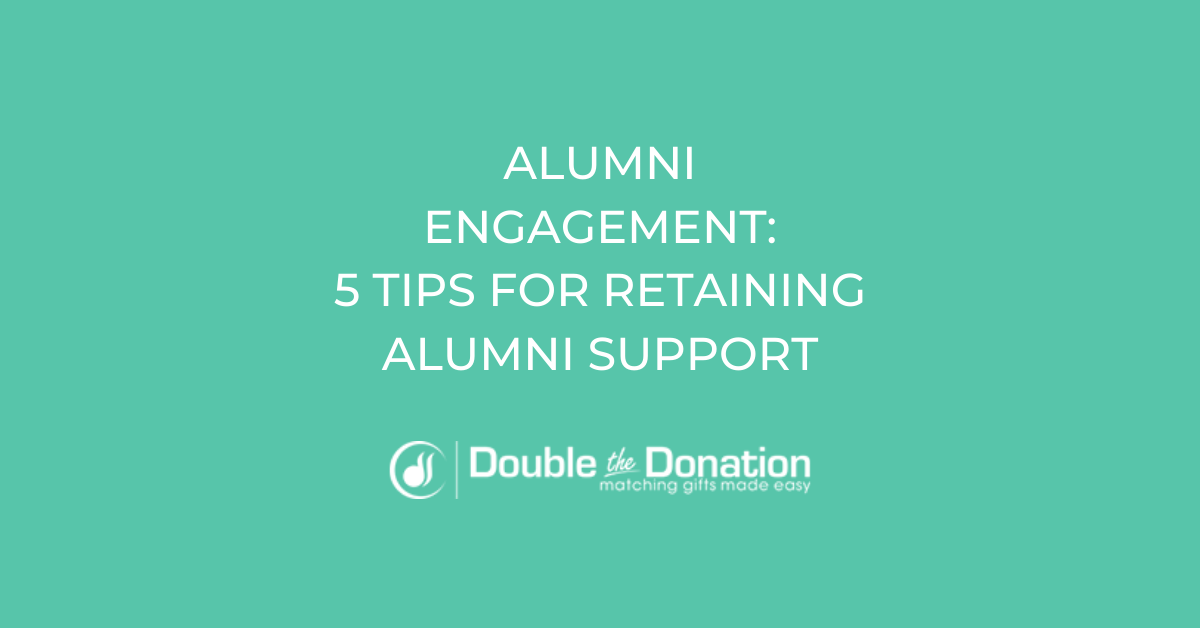min read

Your Giving Day is complete and was a huge success! The hard work dedicated by you and your team has paid off, but it isn’t over.
One of the main challenges fundraisers face is donor retention. Developing a gratitude program that proceeds your giving event should be a priority in your efforts to keep your donors engaged. Communication with gift-givers should extend farther than just the initial event, especially online; these types of digital events require an ongoing story to increase your ROI.
Creating a story around a digital event like a Crowdfunding story or Giving Day initiative will accomplish a few feats:
- Creating value around the fundraising event
- Enhancing donor appreciation by helping them recognize the significance of their contribution
- Demonstrating that a donation is a step in a relationship, not a one-time business transaction
- Showing loyalty to your cause and donors alike
Constructing an ongoing story should be easy for us. Every day, you are a storyteller. From telling the riveting tale of the traffic ticket you just got, to recounting something as boring as a visit to the supermarket, storytelling is a way of life.
Adapting these same, instinctual storytelling mannerisms around your Giving Day event will align your donors’ values with yours. Additionally, it will humanize your cause and be helpful in your efforts of retaining gift-givers.
Any event can be turned into an intriguing narrative.
When developing your narrative, remember these objectives:
Brand Strength
- Ongoing storytelling requires an awareness of consistency. A strong brand increases brand connection, aligning the vision of the organization with that of the donors and investors. To achieve this, keep the branding of the emails, social posts, or any other platform you choose similar, clean, and in tune with the brand of the initial event. Emphasizing continuity will reinforce and remind your donors of your mission. Think of your brand as the glue that holds together your ongoing story, while directly associating it with the value of your efforts.
Value Alignment
- More and more donors are contributing to fundraising initiatives based on whether an organization will enhance their personal brand. How will association with your story further the donor’s interests? Donors and prospects want to invest in organizations whose vision aligns with their own, where their participation will make the most difference, and where their interests will be advanced. In other words, they want to actualize and acknowledge the person they want to be through their impact. Because of this, firmly establish the values you want to portray and make sure those are reflected within any online storytelling and your follow-up.
Think of this blog as your checklist on how to tell lasting stories that are centered around your digital fundraising. Depending on your upcoming events, imagine your story as a cyclical figure. The end goal of your ongoing story should be to transition the narrative into your next event. Seamlessly guide your donors from one giving experience to another, such as an upcoming Giving Day, with the hopes that they trust you enough to contribute again.
Following up with donors and engaged members of your community should not be done as an afterthought, but rather planned in advance. Set aside dates and times to work on outreach.
The following are helpful, time-sensitive benchmarks to hit when extending your story. However, they are just a guide; every organization and story is unique and requires forethought and internal coordination to decide on a timeline.
The Initial Thank You:
1 Second-2 Days After Event

Don’t overlook the importance of expressing gratitude for your donors after the event. Plan to send a thank you ASAP following an online initiative like a Giving Day.
Remember, your donors have shown you the channels they prefer through their method of transaction.
Digital donors should be thanked online with expediency because of the immediacy we’ve come to expect from technology. Meanwhile, offline donors that say, gave through your phone bank, might want a follow-up call. This is not to say you should not incorporate other methods of thanks for select donors. Nothing is quite as impactful or thoughtful as a handwritten letter, so use alternate channels where appropriate.
This type of immediate recognition will shine a spotlight on your donor’s generosity, adding a sense of value to their contribution in the short-term. Let your gift-givers know you didn’t just accept the contribution and then forgot about them.
If you’re drawing a blank, here are some methods of delivering this initial thank you. Try combining as many of these as possible to reach donors who may only engage with you on select channels.
- Thank you video
- Social media post
- Handwritten letter
- Newsletter feature
- Website update
- Thank you page
- Phone call
Take the liberty to add personal touches, this will accentuate the appreciation you feel for your donors. For example, you can use technology like ThankView to create personalized follow-up videos or mention top gift-givers in your newsletter and on your online giving platform.
The Update:
1-2 Weeks After Event

Keep your supporters in the know!
Nothing feels better than being in the loop, especially when you are personally invested in a story. Keep your contributors feeling valued by sharing updates on the general fundraiser as well as specific areas they gave to 1-2 weeks following the event.
Take liberties and get creative with how you distribute this information. Turn to social media, emails, or newsletters. The sky’s the limit when it comes to creating the material. Cater the content you create to the channels you plan on reaching your donors through. Keep in mind that the update doesn’t have to be just one piece. For example, if you want to utilize social media make a small campaign that spans a few weeks.
Whether you choose video, infographics or simply a blog post, find the channel that will best reach your audience and make sure that it has relevant and interesting information. Tell your audience something that they will care about. To achieve this you can include:
- A summary of the event’s accomplishments (How many scholarships were provided or meals donated)
- Overall event results (dollar and donor numbers or top initiatives by either)
- Photos or videos of those who are being impacted
- Shoutouts to major donors and volunteers
- Add a signature or commentary from a prominent event organizer
- Infographics that display the progress of a goal the money is helping achieve
- Updates on the individual story pages written by the fundraising teams responsible
The Personal Call
Within 1 month

One month after your online event, block some time out of your busy schedule to personally extend thanks to donors that may not qualify for major gifts outreach. This may seem time-consuming, but recreating the highly personalized touch major givers receive will assist in the retention area for smaller donors. Focus your efforts on calling donors at a higher gift threshold (such as $1,000+), first-time donors who gave $100+, and donors who made a significant increase in gift amount from a previous fundraiser.
There are a few methods to seamlessly manage this task.
- Recruit personnel or fundraising team members to execute in the calling. It helps when he or she has ties to the story that was donated to.
- Create a rough outline for a script, something along the lines of “Hi ____ this is ____ working for ____, and I just called to say how much we appreciate your recent gift to support our Important Program!”
- Make a record of who you called, whether or not they answered, and the results of the call.
The Slow Nurture
Lasting 1-5 Months Following

How will your story continue after the phone call?
You have updated your donors on the success of the fundraiser, personally reached out to those who gave larger gifts, and have made it a priority to express gratitude to all. Continuing to tell the story, turn to nurturing channels like newsletters, dynamic content, and social media to keep your audience engaged. This stage is in preparation of leading donors to an upcoming fundraiser they will hopefully contribute to.
As an example, when turning to social media it is important to remember the importance of the presence of a strong brand. Utilize social media to tie your values to strong colors, images, and stories. Because it is public, pay attention to the overall message and image you are projecting. In addition, leverage your volunteers and stakeholders to get the word out and expand your affinity network.
For a complete look at scheduling social media messaging before an online fundraising initiative, check out our guide on amplifying your event with a social media toolkit.
The Lead
6 months

There are many benefits to creating an ongoing story surrounding your Giving Day. Remember that a story is cyclical, with the end goal being leading donors to another fundraising campaign. Once you have developed a substantial story around your giving event, you can begin to facilitate reminders and updates of a new event into outreach. An easy way to reach interested parties is to segment the donors into different categories, catering communication efforts tailored to each individual. Try splitting donors by these traits:
- Expected giving level. That way, you can funnel monthly giving prospects down one communication path and major giving prospects down another.
- Past event engagement. Separate first-time donors and gift-giving patrons. Each group should be contacted using a different message. For first-time givers, you’ll want to explain the benefit of giving again.
- Future event interest. Take your list of guests and compare it to your events calendar. Find the right events for the right supporters and send invites accordingly. This can be especially important with first-time donors or micro-sites with a more tailored focus.
- Passion. Possibly the most important factor in messaging, and one that has become easier to uncover as online giving has progressed. Tailor giving opportunities based on the passion the individual has expressed, not necessarily the affinity your presume. For example, a College of Business grad may give $50 to a theatre program even though a college of business funding opportunity was available. They’ve shown they are a patron of the arts and may be more likely to give if you present them with similar stories. Track this metric year over year to build sophisticated donor profiles based around interest and empower your asks.
Ongoing storytelling surrounding your online event should demonstrate gratitude for the donor’s initial gift, reinforce loyalty to the cause, demonstrate a strong brand value alignment, and overall increase donor retention. View this technique as a step to cultivating strong donor relationships.







